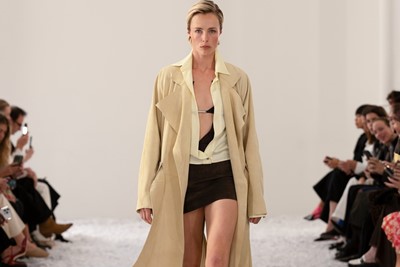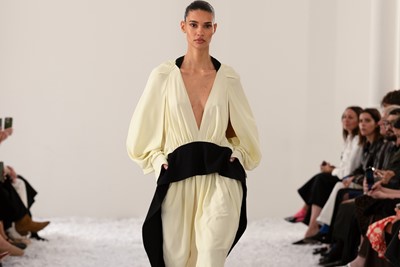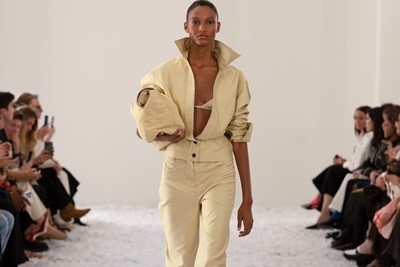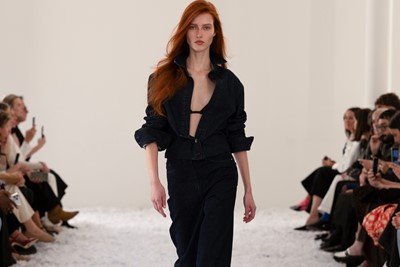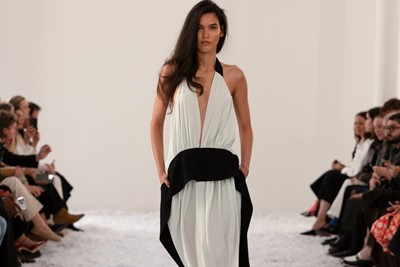Following his Spring/Summer 2025 show for 16Arlington, which referenced the paintings in Pedro Almodóvar’s The Skin I Live In, London-based designer Marco Capaldo discusses the five films that play a powerful role in his work
An airy, white confetti-strewn venue offered the first clue that 16Arlington’s Spring/Summer 2025 collection would mark a departure from last season’s ghoulish exploration of monsters and how they torment our collective conscience. The lights turned a golden hue as Edie Campbell emerged in the first look – a breezy trench worn over an open blouse and a leggy open miniskirt, all in delicious brown and honeyed shades. Along came more bombshells in sheer and feathered garments, some excellent sparkly minis, with voluminous Cindy Crawford hair, each doused in that languid air of indulgence that put the London-based label on the map and into the wardrobes of the city’s It-girls. Here, they sat front row, and smiled approvingly; it appeared their summer wardrobes had been decided for them.
Since the autumn of 2021, the label has been designed solely by Marco Capaldo, who established 16Arlington in 2018 with his late partner in work and in life Federica (“Kikka”) Cavenati. He was born in London to a large Italian family, and studied in east London’s Istituto Marangoni before opening their brand named after the apartment the duo shared in Mayfair. It took barely any time at all for their clothes to appear at almost every party with a Getty photographer present, and even less to write the glittering DNA of the label: clothes to feel fabulous, elegant and empowered, clothes to sheathe you on the best nights of your life.
The latest collection took inspiration from Pedro Almodóvar’s film The Skin I Live In, which follows a brilliant but disturbed plastic surgeon who, consumed by personal tragedy, conducts a sinister experiment on a woman held captive in his secluded mansion. Yes, it’s a little twisted, but Capaldo found the beauty in it. For the show space, Capaldo worked with British artist Jesse Pollock to craft some towering abstract lily sculptures rendered in metal – a motif extracted from one of the carefully curated pieces of art featured in the film. “It feels like a very authentic time in my journey to express what I’ve been yearning for for a while,” he says over Zoom, “which is a real, extreme joy.”
Here, 16Arlington’s Marco Capaldo lists five essential films that have inspired his work thus far.
The Skin I Live In, 2011
“For the past few seasons, I’ve been on a very personal journey, drawn to darker, slightly sinister themes, while always seeking the beauty within them. In Pedro Almodóvar’s The Skin I Live In, I was super inspired by the subtle lighting – those washes of milky yellow, those very specific blue greys. Almodóvar really exceptionally placed artworks within the film, and I went on to do further research about why those pieces were selected – the meanings behind those pieces and how they help tell his narrative.
“The visuals were so vivid that I could almost taste, smell, and touch them. The biggest pull for me was this quote that was scribbled on the wall in the film, which is: ‘Art is a guarantee of sanity’. And it’s a sentence that was taken from one of Louise Bourgeois’ bodies of works called Precious Liquids. Even though it came from initially a more sinister, dark topic, that cue steered me towards that a beauty, towards colour and joy. I’ve ended up on something that feels a lot more relaxed, and there’s a real ease to the collection. Almodovar’s women do inspire me, but on the other hand, he has a much darker view of women. What sits at the heart of 16Arlington is the woman, and even though the season changes or the trend changes, the woman remains.”
Lost Highway, 1997
“Lost Highway by David Lynch is one that I referenced for Spring/Summer 2024. What I love about the film is its openness to interpretation – everyone has their take on it, which speaks to the complexity of Lynch’s work. I took away the duality that Lynch presented – the idea of, are you living in a dream state, or are you living in reality? That narrative kickstarted the inspiration for S/S24 because I wanted to prompt a double-take, whether that was in fabrications – I created sequins out of latex, or I created sequins out of metal, which on first glance look like sequins until they brush past the audience, or you hear them moving.
“The dialogue also had a powerful impact. Collaborating with art director Olu Odukoya, we printed unfinished sentences across the seating of the show. When I reference films or art, I aim for an organic connection rather than a literal translation into the collection, allowing the inspiration to flow subtly without direct imitation.”
Closer, 2004
“I was probably quite young when I saw Closer by Mike Nicholas. That graphic of Natalie Portman in that pink wig … I remember seeing that everywhere. I remember that scene where Natalie plays a stripper, and she’s performing a dance in like the most incredible bejewelled bralette and like lace knicker. I specifically remember the lighting, how it enhanced the plot line, with mature performances from an all-star cast.
“What I love about Closer is that it’s such an incredible kind of social study on human behaviour. From great sadness to deep depression to real highs – it takes us through so many emotions that we can relate to. There’s something so raw about it, and the way that it was captured and combined with all those other ingredients with real affection, it’s just brilliant.”
Mickey Blue Eyes, 1999
“My fourth film is a bit of a curve ball, but we just need real comedic respite: Mickey Blue Eyes. I love comedy, and this film, with its crazy Italian family and Hugh Grant as a British auctioneer, hits close to home. While my family isn’t part of the mafia, there's something about the Italian immigrant culture that resonates. Especially from the younger generation in our family, there’s this understanding that you’re watching something quite close to home in all the chaos that comes with being part of a large Italian family.
“My grandparents come from a tiny village in Italy. Now it’s as if they’ve been cut out of that village in Italy and plonked in London. Whether it’s growing their vegetables in the garden, or continuing to only speak Italian, there's this inexplicable parallel between my family and this film. Being Italian, everyone is welcomed in as if they are family. It’s all built upon a basis of love and acceptance. There’s never a Christmas where we haven’t brought friends to the table, it’s always an open door.”
La Grande Bellezza (The Great Beauty), 2013
“La Grande Bellezza by Paolo Sorrentino is such an incredible portrayal of the real Italian way of living, and it’s such an incredible expression of the joy and energy that runs through the culture. I’m a Libra, so I’m very attracted to to very beautiful things. I remember when that film came out I was at university during a term of where we were studying tailoring. I remember always referencing that film because the costume design was so amazing.
“I remember the really pivotal quote from one of the film’s opening scenes: ‘Travelling is very useful: it makes your imagination work. Everything else is just disappointment and trouble. Our journey is entirely imaginary, which is its strength.’ There’s something really beautiful in that, because even though it’s in a chaotic scene, there’s something incredibly poetic about the way it was narrated. It’s the ultimate depiction of Italian excess and frivolity. It’s all about the sex and the drugs and the rock-and-roll, but somehow it’s incredibly poetic at the same time.”

